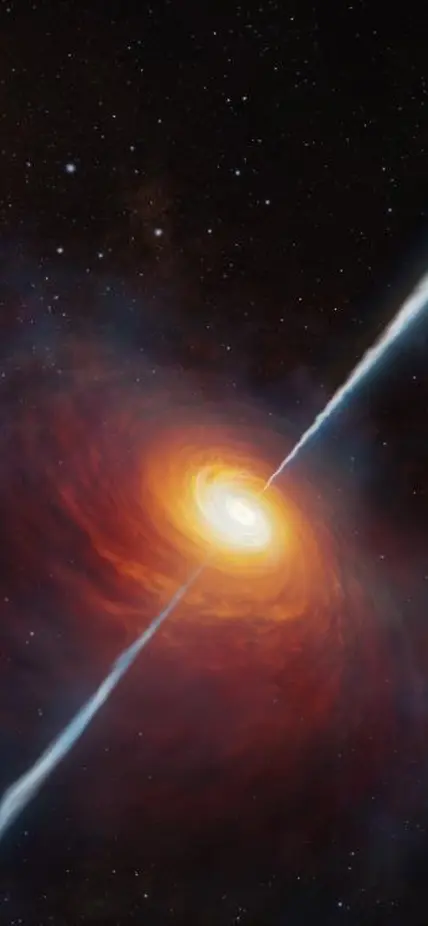Pasadena, CA— The Magellan Baade telescope at Carnegie’s Las Campanas Observatory played an important role in the discovery of the most-distant known quasar with a bright radio emission, which was announced by a Max Planck Institute for Astronomy in Heidelberg and European Southern Observatory-led team and published in The Astrophysical Journal. One of the fastest-growing supermassive black holes ever observed, it is emitting about 580 times the energy as the entire Milky Way galaxy.
Quasars are incredibly luminous supermassive black holes accreting matter at the centers of massive galaxies. Their brightness allows astronomers to study them in detail even at great distances.
Using a complement of seven telescopes around the world, a research team co-led by MPIA’s Eduardo Bañados and ESO’s Chiara Mazzucchelli spotted a quasar, called P172+18, from when the universe was only 780 million years old. This makes it about 100 million years older than the previous record holder.
“The observations are not just for chasing distance records, but to try to understand unsolved mysteries of the cosmos” explained Bañados (who is a former Carnegie postdoc).
Such distant quasars with bright radio emissions provide essential information to study the formation and evolution of massive galaxies and black holes in the early universe.
P172+18’s black hole mass amounts to about 70 times the mass of its counterpart in the Milky Way center, and it is still rapidly growing. The measurements indicate this quasar hosts one of the fastest accreting supermassive black holes known.
Astronomers use infrared cameras and spectrographs to capture the light emitted by objects from the early universe, such as P172+18. To achieve the necessary precision for this project, the researchers combined observations from the Magellan Baade Telescope at Las Campanas Observatory (Chile), the Nordic Optical Telescope (NOT) on La Palma (Spain), the Keck telescope in Hawaiʻi (USA), the Very Large Telescope (VLT) of the European Southern Observatory (ESO Chile) and the Large Binocular Telescope (LBT) on Mount Graham (USA).
P172+18 was one of several quasar candidates identified by a review of data from the Panoramic Survey Telescope and Rapid Response System, or PanSTARRS, Bañados said, adding: “ultimately, however, we needed precise observations with infrared telescopes to determine the distance of the quasar and the black hole properties.”
While studying the radio data, the researchers discovered another source in P172+18’s vicinity, but they have not yet determined its redshift and distance. Due to the quasars’ spatial distribution, the probability of another chance hit in the immediate vicinity is very low. Bañados is now leading a team that is trying to confirm whether these two sources are physically associated. If true, the discovery of early galaxy grouping would be spectacular because explorations of structure formation in this epoch are just beginning.
“Our measurements show that P172+18’s radio properties are rather average compared to other radio-loud quasars,” Bañados notes. “That’s why we are optimistic and suspect there are many more radio-loud quasars to be discovered out there, perhaps at even larger cosmological distances. Our search continues.”
Astronomers still don’t know why different quasars exhibit such a wide variety of radio emissions. Studying them at the earliest possible cosmic epochs can provide clues about how supermassive black holes grow. It is one of the biggest mysteries of astrophysics that still needs to be solved.
Top Image Caption: This artist's impression shows how the distant quasar P172+18 and its radio jets may have looked. To date, this is the most distant quasar with radio jets ever found. It is so distant that light from it has travelled for about 13 billion years to reach us: we see it as it was when the Universe was only about 780 million years old. Image credit: ESO/M. Kornmesser
